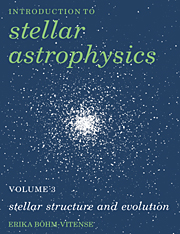Book contents
- Frontmatter
- Contents
- Preface
- 1 Introduction
- 2 Hydrostatic equilibrium
- 3 Thermal equilibrium
- 4 The opacities
- 5 Convective instability
- 6 Theory of convective energy transport
- 7 Depths of the outer convection zones
- 8 Energy generation in stars
- 9 Basic stellar structure equations
- 10 Homologous stars in radiative equilibrium
- 11 Influence of convection zones on stellar structure
- 12 Calculation of stellar models
- 13 Models for main sequence stars
- 14 Evolution of low mass stars
- 15 Evolution of massive stars
- 16 Late stages of stellar evolution
- 17 Observational tests of stellar evolution theory
- 18 Pulsating stars
- 19 The Cepheid mass problem
- 20 Star formation
- Appendix Radiative energy transport in stars
- Problems
- References
- Index
19 - The Cepheid mass problem
Published online by Cambridge University Press: 08 January 2010
- Frontmatter
- Contents
- Preface
- 1 Introduction
- 2 Hydrostatic equilibrium
- 3 Thermal equilibrium
- 4 The opacities
- 5 Convective instability
- 6 Theory of convective energy transport
- 7 Depths of the outer convection zones
- 8 Energy generation in stars
- 9 Basic stellar structure equations
- 10 Homologous stars in radiative equilibrium
- 11 Influence of convection zones on stellar structure
- 12 Calculation of stellar models
- 13 Models for main sequence stars
- 14 Evolution of low mass stars
- 15 Evolution of massive stars
- 16 Late stages of stellar evolution
- 17 Observational tests of stellar evolution theory
- 18 Pulsating stars
- 19 The Cepheid mass problem
- 20 Star formation
- Appendix Radiative energy transport in stars
- Problems
- References
- Index
Summary
Importance of Cepheid mass determinations
We know that Cepheids must be in an advanced state of evolution because the blue loops are the only way they can stay in the instability strip for any length of time. If we can determine mass and luminosity for a Cepheid we can check whether its luminosity agrees with what we expect without overshoot or additional mixing. A larger L might indicate additional mixing (see Fig. 15.3). In fact we could calibrate the amount of mixing for the Cepheid progenitor on the main sequence by determining mass and luminosity for a given Cepheid. Of course, we also have to know the chemical abundances and the correct κ. For a given L the derived masses of the Cepheid may differ by 50 per cent if for instance the assumed helium abundance is changed by a factor of 2.
We can also check the consistency of the stellar evolution and pulsation theories by determining masses of Cepheids in different ways, making use of either evolution or pulsation theory or of different aspects of those theories. If the theories are correct we should, of course, find the same mass, no matter how we determine it.
The period–luminosity relation
A number of Cepheids are found in galactic clusters. Their periods can be measured and their distances can be determined, for instance, by main sequence fitting or equivalent methods. We can thus find their absolute magnitudes averaged over one period. The first extensive study of distances for clusters with Cepheids was done by Sandage and Tammann (1968), and a more recent one was done by Schmidt (1984).
- Type
- Chapter
- Information
- Introduction to Stellar Astrophysics , pp. 238 - 244Publisher: Cambridge University PressPrint publication year: 1992

